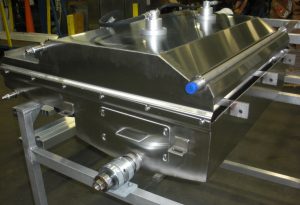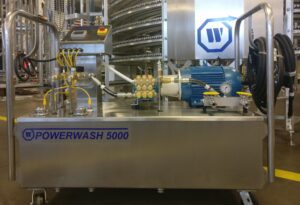Technical Bulletin 5 – Spiral Belt Maintenance
CLEANING FOR OPTIMUM PERFORMANCE
Maintaining a clean Spiral Belt and Wearstrips is essential for lowering Belt Tension and for optimal System operation.
The System application and product on the Belt, coupled with the surrounding environment and operating temperature, all determine the required cleaning frequency.
Dirty belts, contaminated Vertical Cage Bar and Track Wear Strips are the primary cause of tension in the System. The Belt must be kept clean so that it functions properly and collapses as it goes around the Center Cage. If the Belt becomes clogged or covered with debris, it cannot collapse and will buckle up along the inside edge. Even a slight amount of dirt or grime will affect the Belt and System performance.
 Typhoon Belt Washer
Typhoon Belt Washer
 Powerwash 5000
Powerwash 5000
METAL SPIRAL BELT
Only use “Dawn” Dishwashing Detergent. Never use Caustic Cleaners or De-greasers.
The Spiral Belt must be kept clean so that it can collapse as it enters and travels around the Spiral Cage. As the belt becomes covered with debris, friction increases between the Belt and Track Wearstrip.
- Utilizing the Spiral Belt Washer with high-pressure water @ 500 PSI or more is a very effective means of removing most debris.
- To achieve the best results, the Spiral Belt speed should be reduced to as slow as possible. A complete cleaning may require multiple passes through the Belt Washer.
- During the washing cycle, activate the air manifolds to remove the excess water and debris from the belt.
- After washing, the air manifolds can remain on to achieve better belt drying. If you have I.J. White Dip Tanks or if any excessive dirt has accumulated on the Spiral Belt, a manual steam cleaning may be necessary. Call our Technical Service Group for recommended guidelines.
PLASTIC SPIRAL BELTS
Only use “Dawn” Dishwashing Detergent. Never use Caustic Cleaners or De-greasers.
The same parameters for cleaning Metal Belts should be used for the cleaning of Plastic Belts. Wipe away all large or loose debris from the Belt Surface, Pulleys, and Sprockets. The Wear Strips must be clean for the Belt to travel freely through the System. Do not exceed 500 psi when washing Plastic Belts.
Key Warning Signs that cleaning is needed:
- High Belt Tension
- Rising Take-Up Motor Amps
- Center Cage Overdrive Is High
- Belt Lifting Off Track Supports
- Oily Feel to Vertical Cage Bars
- Presence of Oxidized Oils
- Residue Build-up on Track Wear Strips
If the any of the above conditions exist, clean the following:
- Spiral Belt
- Vertical and Track Wearstrip
- Belt Drive Sprockets
- Pulleys and Side Rollers
PM Actions:
- Inspect and repair the entire belt for any damaged sections
- Inspect the inside and outside edges of the belt for any broken links, welds, or protruding buttonheads
- Inspect and measure the belt for any excessive stretch or elongation
- Make sure the Spiral Belt, Vertical Cage Bar Wearstrips, and Track Wearstrips are thoroughly cleaned
- If the product generates excessive residue/oil in the System, then it will be necessary to include a wash down in your PM program in addition to the regular sanitation measures
EXTENDING SPIRAL BELT LIFE
There are steps that can be performed to extend the life of the Spiral Belt. Besides regular cleaning, the most critical preventative maintenance procedure is flipping the Spiral Belt.
FLIPPING THE BELT
Please contact the I.J. White Technical Service Group before flipping or turning any Belt.
Many types of metal belts can be flipped to even the natural stretch that occurs of the outside edge. The purpose of flipping the Spiral Belt is to ensure that the amount of stretch is evenly distributed on both the inside and outside of the belt.
Note: Not all Spiral Belts can be flipped. The edge construction must be the same on both sides of the Spiral Belt so it can be flipped.
MEASURE METAL BELT STRETCH
Normally, the outside edge of the belt is under tension and will stretch faster than the inside edge. Below is a guideline for measuring Belt Stretch.
Note: If the Spiral Belt is stretched more than 3/16”, this would be considered excessive and the Spiral Belt should not be flipped or turned.
Only flip the Belt after completing the following procedures:
- Measure the Belt Overdrive
- Measure Belt Stretch
- Check Hour Meter for System operating time
- Inspect Belt for any damaged areas
- Repair or replace any damaged sections
BELTS
1.GRID: 1” PITCH
FLEX: 1/3” x 1” , 1” x 1” , 1/2” X 1”
Measure 12 (pitches) connector rod buttons on the inside edge of the Spiral Belt and 12 connector rod buttons on the outside edge of the Spiral Belt. This should be done on the Infeed or Discharge of the Spirals straight Belt. If the outside edge measures 1/16” or more than the inside edge, the Belt must be flipped or turned over.
2.GRID BELTS: 3/4” PITCH
Measure 16 (pitches) connector rod buttons on the inside edge of the Spiral Belt and 16 connector rod buttons on the outside edge of the Spiral Belt. This should be done on the straight section of the Infeed or Discharge. If the outside edge measures 1/16” or more than the inside edge, the Belt must be flipped.
The following factors must be considered, along with Belt Stretch, prior to flipping or turning the Belt:
- Operating Hours of the System
- Condition of the Spiral Belt
- Broken Welds or Links on the outside or inside edge of the Spiral Belt. These must be repaired or replaced prior to flipping or turning.
OPERATING HOURS
The Spiral Belt should be flipped at 2000 hours of operation. The 2000 hours is based on an eight (8) hour shift, five (5) days per week and fifty (50) weeks per year operation. Plants running multiple shifts and extended hours will have to flip the Belt more often throughout the year. This information should be used as a guideline along with measuring the actual Belt stretch.
SYSTEM UPGRADE PACKAGES
I.J. White Technical Service Group now offers these new Upgrade Packages that can be installed on existing systems:
- Automatic Belt Tension (ABT): Patented System to reduce spiral belt tension
- Belt Overdrive System (BOS): Accurately measures system belt overdrive. Increases belt life and reduces system tension.
- Track Glide Z-6000: Automatic Belt Lubrication Systems
- Powerwash 5000: High Pressure Portable Cleaning Systems
- Personnel Safety Alert: Designed to protect your employees
Technical Services Programs
- PM Video
- On-Site System Training
- PM Service Programs
- Cleaning Systems
- Belt Cleaning Bulletin
- Operations Manual
- Replacement Parts
- Upgrade Packages
For more information, call our Technical Service Group at 631-293-2211 or email service@ijwhite.com.
Technical_Bulletin_5._Belt Maintenance.pdf
